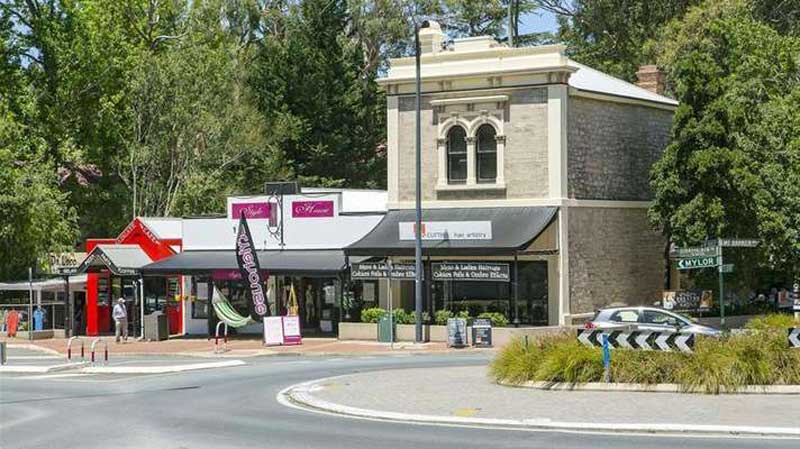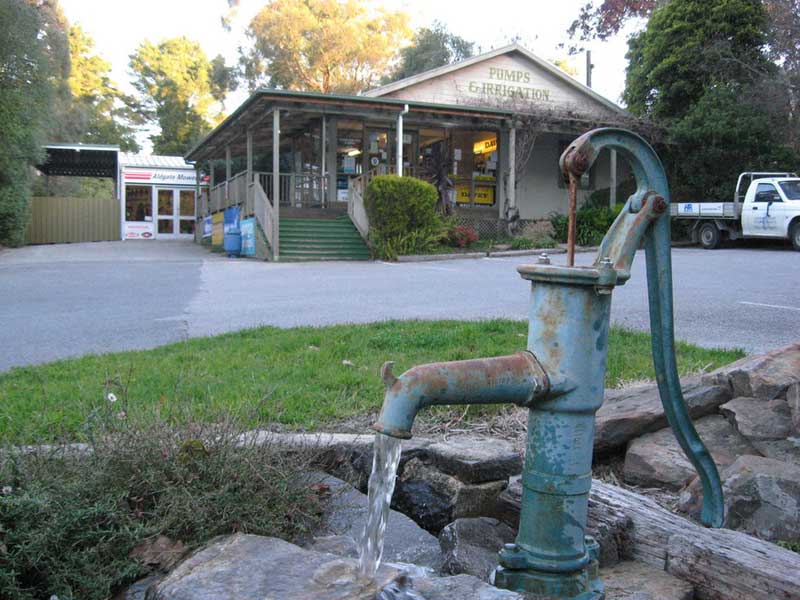Adelaide, South Australia
Aldgate
Aldgate, is a charming village with historic buildings and leafy trees and gardens lining one side of the main road. The trees give a spectacular colourful display in autumn and provide a backdrop of green in summer. Walking trails around leafy streets and parks are of interest.Where is it? 21 kilometres south-east from the Adelaide city centre, in the Adelaide Hills.
Aldgate is the site of Stangate House and Garden, a property bequeathed in 1975 to the National Trust of South Australia. The house was built in 1940 and is well known for its stunning gardens.

Aldgate is most famous for the Aldgate Pump which sits over the road from the Aldgate Pump Hotel. The pump was used to water the horses and bullock teams which passed through the area on their way south to the Echunga goldfields.

Aldgate's drainage system has suffered substantial problems and has been the result of drastic flooding through the main street. One of the worst cases of this occurred at around 8:00 AM 8 November 2005, which left most of the businesses in the main street flooded with significant damage. A recent ongoing project around Aldgate has been upgrading the drainage system. In 2009 and 2010 the intersection of Mount Barker Road, Strathalbyn Road and Kingsland Road in Aldgate was upgraded and streetscape works were carried out throughout the township. To make way for the roadworks, the pump which was the centrepoint of the town was temporarily removed. It was reinstalled in May 2011 by the Adelaide Hills Council and now sits atop a pedestal on the footpath in the main street.
Over the road from the hotel is the pump (not the original one - and not in the original location) and the delightful 'General Store' - now a crafts shop - which dates from the early 1880s when building blocks were offered for sale in Aldgate. It has changed hands and functions many times. At various points it has been a general store, a butcher's shop and, in the 1890s, the Hills Cash Store.
Stangate House and Garden
In 1975 Stangate House was bequeathed to the National Trust of South Australia. It is an attractive house dating to 1940 but the attraction is the garden with its huge oak tree (some suggest it dates from 1864 and was originally planted by Richard Hawkins) and its displays of camellias, hydrangeas and rhododendrons. The gardens were recognised by the International Camellia Society in 2012 as an International Camellia Garden of Excellence, at the time one of only 3 in Australia and only 30 worldwide. It is also the home of the Camellia Society Adelaide Hills Inc.Location: 3 Edgeware Road, Aldgate 5154. Ph 0408 081 124. Open every fourth Sunday. Entry fees apply.
Adelaide Hills Wine Region
Wine grapes were first planted in the Adelaide hills in the early 1840s. Situated east of Adelaide, the long and narrow Adelaide Hills region runs through the southern Mt. Lofty ranges. It is one of South Australia's largest wine growing regions, stretching from the edge of the Barossa and Eden Valleys in the north, to the boundaries of McLaren Vale and Langhorne Creek in the South. The high altitude combines brilliantly with the favourable climate, to allow grapes to mature at a slower pace than other regions, giving the wines intense elegant flavours and characteristics.One of the earliest wineries and vineyards in the area is mentioned in the Adelaide papers for sale as follows: 1865 - Swithen Farmer - Section 6131 "Chain of Ponds". Winemakers plant complete with several thousand gallons of wine, wine presses, fermenting vats, casks, large boilers. Wine vintages 1863-1865. 16 acres of vineyard.

About Aldgate
Brief history: The town of Aldgate was supposedly named in 1882 after the local hotel the Aldgate Pump, which was named by Richard D. Hawkins, who had additionally opened the nearby Crafers Inn. The hotel was named after the pump he had installed outside, and Aldgate in London, England, which is an Old English derivation of old gate.The pump became popular to water the horses and bullock teams which passed through the area on their way south to the Echunga goldfields. By 1870, a small settlement had been established with many buildings remaining to this day. Hawkins claimed at that time that some 60,000 people a year passed through the hotel's doors. The hotel became quite famous. At one point it was described as 'one of the best decorated of its kind in the colony' with 'magnificent chandeliers'
The Hills Land and Investment Company subdivided land in the Aldgate area for settlement in 1882. For a few months in 1883 it was the end of the railway line from Adelaide. In November of that year, the railway was extended through to Nairne.








